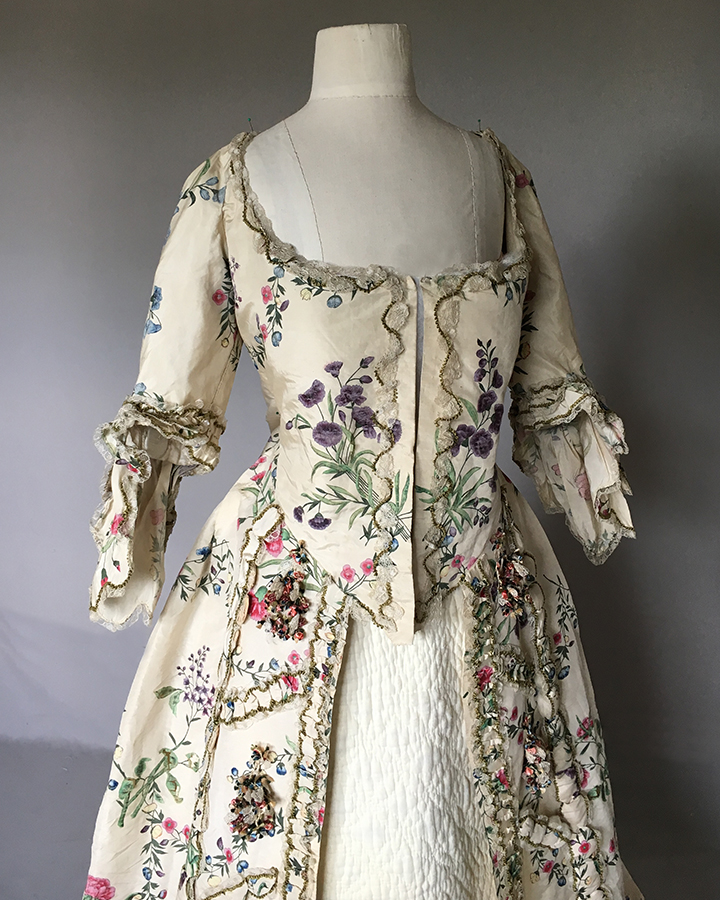
SOLD
Hand Painted Chinese Gown
Silk 1760s; Gown 1770s
This extremely rare and sensational sack back gown (robe a la francaise) gown is in remarkable condition with bright clear fresh unfaded colours. The fabric would have been extremely expensive and it would have been made for a very special occasion such as a wedding or court gown. One unusual feature is that the flowers are very much recognisable British flowers, such as roses, carnations (pinks) and lilac, rather than Chinese species. It is also good to see the two large lead weights encased in lining linen, inside the sleeve ruffles. This was to keep the sleeve in place when moving the arm.
Similar examples can be found in major museums throughout the world including the V & A London; the Metropolitan Museum, New York, Kyoto Fashion Museum, Japan; Colonial Williamsburg, Virginia USA; Museum of Fine Aers, Boston, USA; Royal Ontario Museum, Canada and many more. The dress was kept in a box in the vendor's house for 40 years!
The placing of the design of the silk on the bodice and sleeves has been considered with matching pattern. This is not always the case on 18th century gowns where the design can be quite randomly placed. The gown would have been worn with lace ruffles, a matching petticoat (now missing) and a large fichu, probably tucked into the bosom. I have not seen fly braid presented in little falling bunches such as here. More usually it is applied as a braid to the front of the gown.
Wallpaper and silks were probably hand painted in the same workshops in Canton, since the technique to hand stain wallpaper was very similar to hand painted silks. To prepare the silk panels for painting the silk is stretched over a board or stretcher and painted with a large brush with a glue and alum mix. When dry the silk is peeled off the stretcher and is ready to be painted with pigments.
A contrasting selvedge, here in yellow, was characteristic of Chinese trade silks.
Chinese hand painted paper and silk was exported to Europe in large quantities to adorn the houses of the rich. 'Chinese Rooms' were a popular feature of country houses for those who could afford it. Not only was it used for covering walls but also for bed and window curtains. The paper can be found in many National Trust and privately owned houses in the UK. The Chinese Chippendale room in Badminton House in Oxfordshire is a well known example. The silk and paper intended for wall coverings and funrishings tended to have exotic birds, butterflies and scenes of Chinese people. Dress silks only have floral designs and sometimes butterflies.
Cataloguing
The sackback dress with large scoop neck, front closure, edged with fine bobbin lace and applied with curving sage green silk, the elbow length sleeves have a double sleeve ruffle, one much longer, scalloped and similarly embellished, two large circular lead weights are sewn into each of the linen sleeve linings, the front skirt sides each with a panel edged with narrow horizontal pleats, edged with similar lace and silk edging, the inner panel with puffed loops, some filled with original sheeps wool and with similar edged lace and silk, with four similar diagonal bands widening to the hem, groups of silk fly braiding sewn between the diagonals, the back with large flat pleats opening onto a full skirt.
The ivory silk taffetta hand painted with outlines in ink and painted with pigments. Naturalistic and delicate large flower sprays including roses, carnations or pinks, lilac, bell shaped flowers and others amongst garlands of small flowerheads, using deep pink, dull purple, lemon, mid blue, and two shades of green pigments, the woven selvedges in yellow.
Hem circumference 11ft 2 in; 3.4 m
Shoulder to back hem 5ft 7 in; 1.7 m; Shoulder to front hem edge 5ft 1 in; 1.55m
Bust 38 in; 97 m.
Width of silk 28 1/2 in; 72 cm. Pattern repeat 30 in; 77 cm drop
None of the silk was cut but turned in on the skirt openings. Ask for photos.
Condition
In remarkable condition. There is no fading and the colours are bright. There is one small light brown circular stain to the back hem area 2 x 1.5 cm. Some of the sheeps wool is missing from the skirt front puffs. One group of fly braiding is missing from the right hand side of the gown (as you look at it).
Due to movement of the silk when worn the lighter green pigment has fractured on many leaves. A review of papers on Chinese painted silk dress has revealed that splitting of the silk ground fabric in areas painted green was a common problem. This has been attributed to the use of the copper-based mineral malachite to produce the characteristic bright green colours in Chinese painted silks.* This is a common problem with hand painted silks and there are various papers produced on it, by museum conservation teams who own similar dresses. I have spoken to Janie Lightfoot a well known textile conservator, about the dress who tells me the green areas can be stablilised and supported. They can even paint the leaves on the stablising fabric!
Comments
Conservation papers on Chinese painted dresses held at museums.
*http://www.vam.ac.uk/content/journals/conservation-journal/issue-49/encounters-with-paper-conservation-the-treatment-of-a-chinese-painted-silk-dress/
*http://www.gutenberg-e.org/lowengard/C_Chap43.html
For museums with Chinese export hand painted silk dresses:
http://www.larsdatter.com/18c/painted-silk-gowns.html
See: Interwoven Globe 1500-1800 ed Amelia Peck p 297
What Clothes Reveal by Linda Baumgarten p 37
